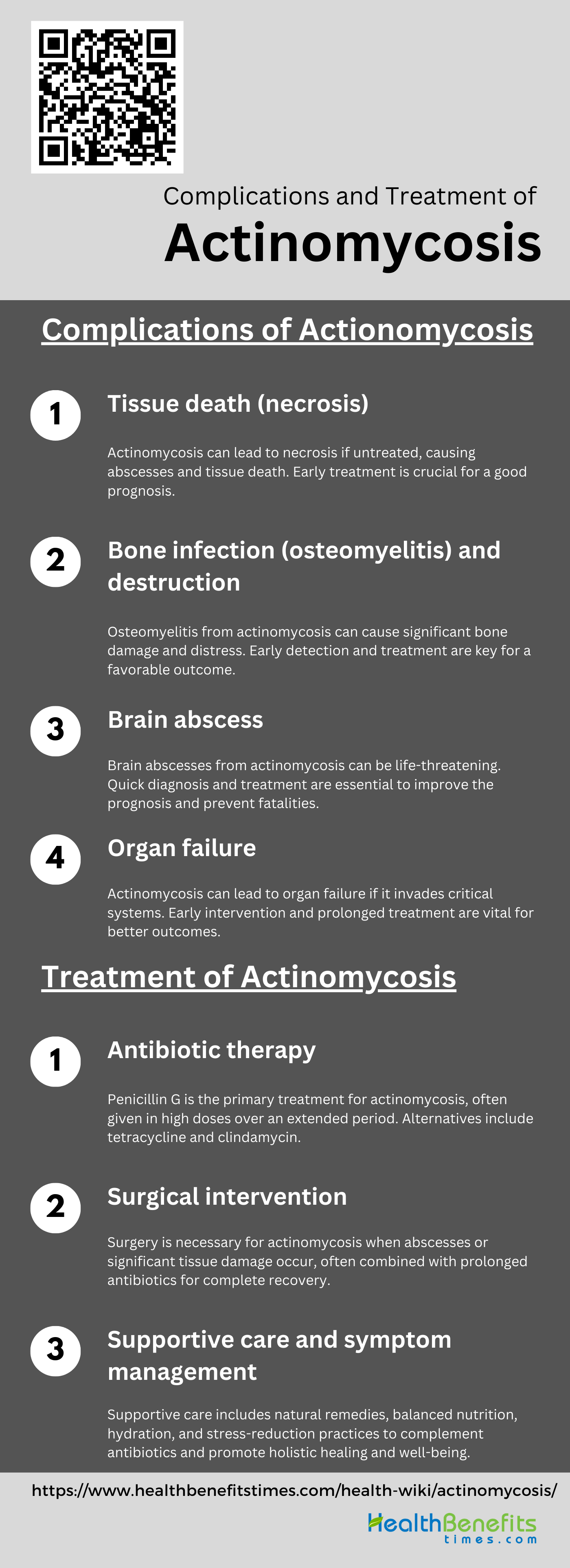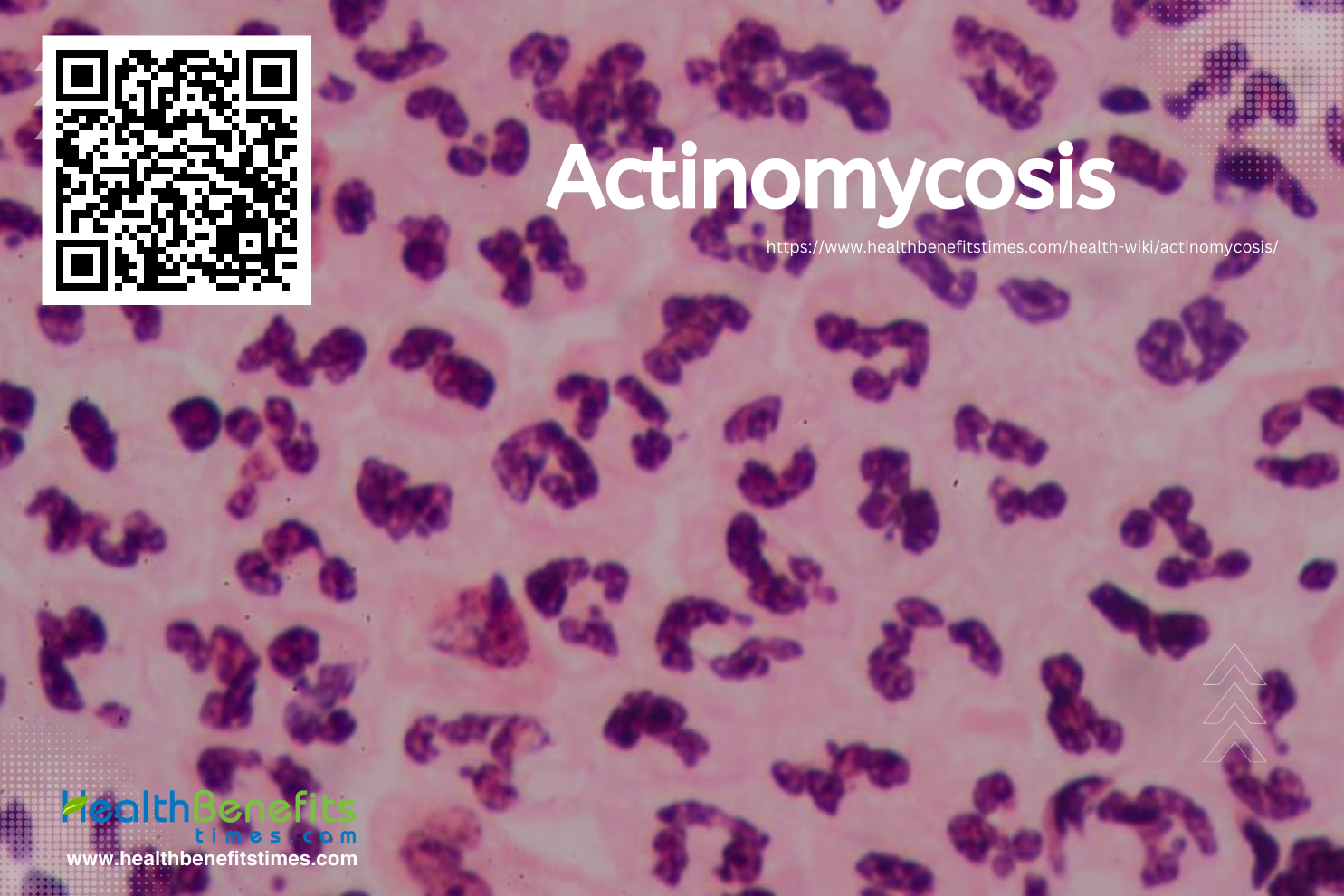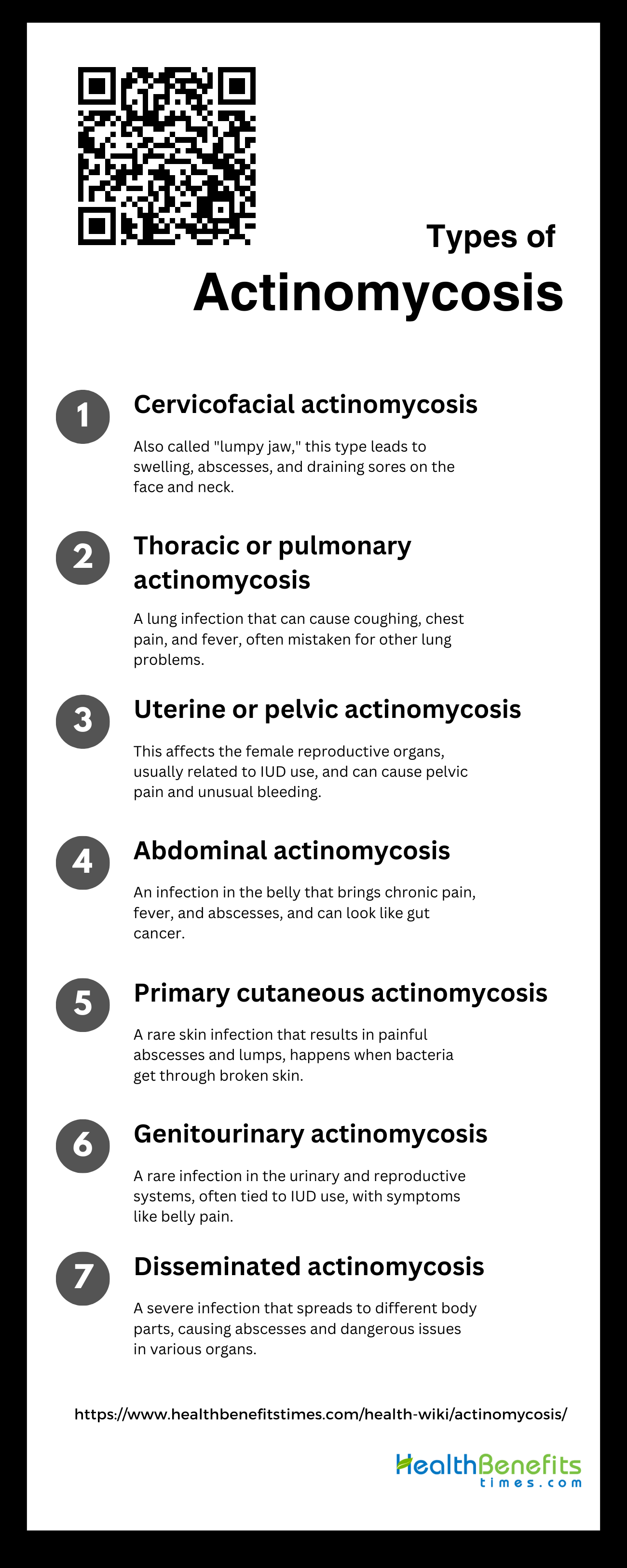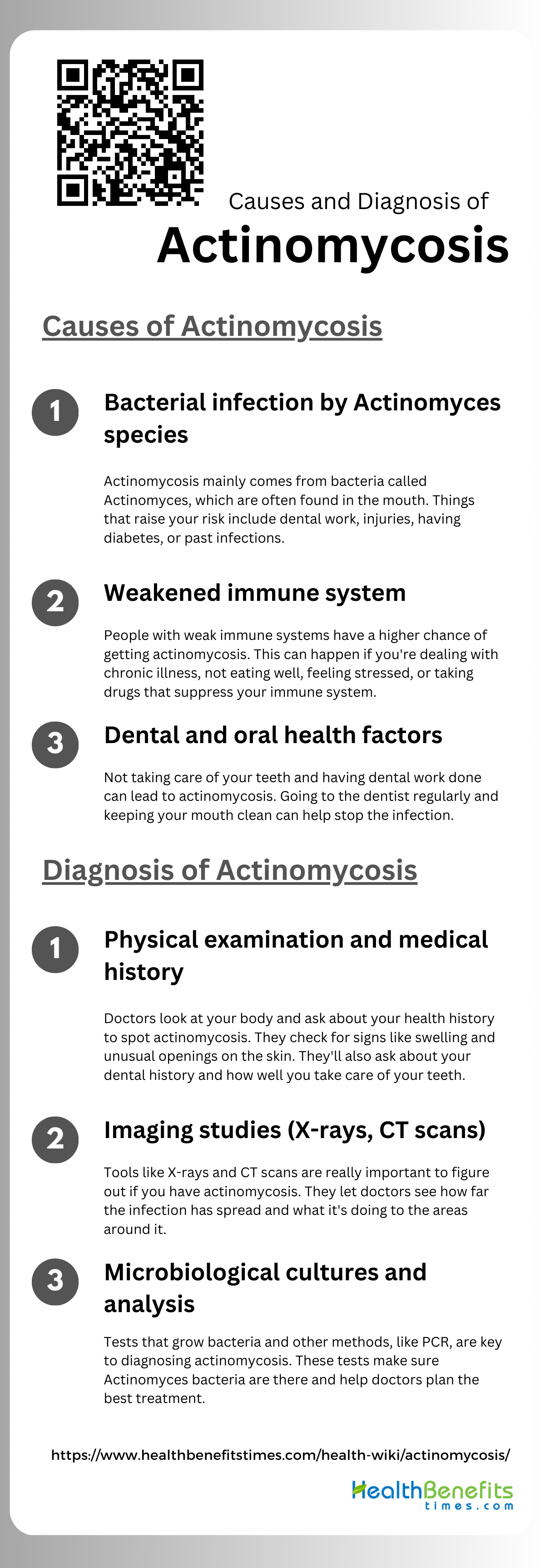Actinomycosis is a rare but tricky infection to diagnose because its symptoms are not specific and can look like more serious diseases, including cancer. It’s caused by Actinomyces bacteria, which are usually harmless in the mouth, stomach, and reproductive areas. But if these bacteria get through the body’s barriers after an injury, they can cause painful abscesses, hardening of tissue, and draining sores. This shows how important it is to have a healthy balance of microbes and strong natural defenses in our bodies. Knowing about actinomycosis helps us see how keeping our body in balance is key to staying healthy. It reminds us to take care of ourselves in a well-rounded way.
Types of Actinomycosis
Knowing the different types of actinomycosis helps catch it early and treat it well. Here, we look at the various kinds of actinomycosis, each with its own symptoms and ways to treat them.
-
Cervicofacial actinomycosis
Cervicofacial actinomycosis, also known as “lumpy jaw,” is a rare infection that hits the face and neck. It’s mostly caused by the Actinomyces israelii bacterium, which lives in your mouth and throat without causing harm. But if dental issues or injuries occur, it can cause painful swelling, abscesses, and draining sores. The symptoms might look like cancer or tuberculosis, but checking the tissue under a microscope is needed for a correct diagnosis. Besides antibiotics, keeping your mouth clean, eating right, and having a strong immune system are key to stop it from coming back and staying healthy.
-
Thoracic or pulmonary actinomycosis
Thoracic actinomycosis is another rare infection caused by Actinomyces species. It’s hard to tell apart from other lung diseases because it causes a lasting cough, chest pain, and fever. This infection affects the lungs and chest when mouth bacteria get breathed into the lungs. This can hurt lung tissue and lead to abscesses over time. Catching it early is important, and doctors often suggest using both antibiotics and natural remedies to strengthen the immune system and lungs. Changing your lifestyle and diet to reduce inflammation and boost immunity is also crucial for dealing with this tough condition.
-
Uterine or pelvic actinomycosis
Uterine or pelvic actinomycosis is a rare bacterial infection that targets women’s reproductive systems. It’s usually linked to long-term use of intrauterine devices (IUDs). Symptoms like pelvic pain, unusual bleeding, and weight loss can be confused with other gynecological problems, which can delay finding out what it really is. For those focusing on holistic health, regular check-ups and talking openly with doctors are important. Quick treatment, which may include antibiotics or surgery, is key to managing the infection and keeping your health and fertility.
-
Abdominal actinomycosis
Abdominal actinomycosis is a serious infection that can fake being a stomach cancer. It brings ongoing belly pain, fever, weight loss, and can cause abscesses and inflamed masses. It happens when the Actinomyces israelii bacterium, normally in the mouth and gut, infects the belly organs after surgeries or appendicitis. Keeping your gut healthy is vital to avoid these infections. Spotting it early with scans and tests, followed by long-term antibiotics and sometimes surgery, is how you deal with it. This disease shows why it’s so important to look after your health all around, prevent problems, find them early, and treat them well.
-
Primary cutaneous actinomycosis
Primary cutaneous actinomycosis is a rare skin infection caused by Actinomyces bacteria. These bugs usually live in your mouth and breathing tract but can infect the skin if there’s a cut or scrape, leading to painful abscesses and lumps. Signs include swelling, sores, and sometimes, sulfur granules coming out. To avoid this, it’s good to prevent skin injuries and keep your immune system strong with a healthy diet, exercise, and less stress. Getting medical help fast is vital, often needing long-term antibiotics and maybe surgery to remove infected areas and help healing.
-
Genitourinary actinomycosis
Genitourinary actinomycosis is a rare infection that strikes the urinary and reproductive systems. Actinomyces species cause it, especially after injuries, surgeries, or using IUDs. It comes with vague signs like belly pain or a lump that can seem like a tumor, making it tricky to diagnose. Without treatment, it can cause serious issues like fistulas. Finding it early and having a full treatment plan are musts, usually with long-term antibiotics and possibly surgery. A balanced diet and good stress control can help you recover and stop it from coming back. Knowing about this condition is key for the best health results.
-
Disseminated actinomycosis
Disseminated actinomycosis is a severe infection that spreads and can threaten your life. It shows how invasive Actinomyces species can be, causing abscesses and looking like other serious conditions such as colorectal cancer or heart issues. Symptoms change depending on where it spreads, with possible signs like fever, weight loss, and problems specific to certain organs. For those into holistic health, fitness, and wellness, catching it early and treating it fully is super important. This usually means using antibiotics for a long time and maybe surgery. Understanding how it appears and the need for an all-inclusive health approach, mixing medical care with good food and other supportive treatments, is vital for getting over this tough infection.
What Causes Actinomycosis and Who’s at Risk
Actinomycosis is a rare infection caused by the bacterium Actinomyces israelii. Poor oral hygiene, dental infections, and certain medical procedures can raise your risk, especially if your immune system isn’t strong.
-
Bacterial Infection by Actinomyces
This serious infection comes from bacteria often found in the mouth, and sometimes in the gut and genital areas. It usually starts when these normally harmless bacteria get through the mouth’s lining due to injury, dental work, or poor oral care. Key risks include a weak immune system, recent dental work, face injuries, diabetes, using IUDs, and past surgeries or infections that let bacteria go deep into tissues. Quick treatment is key and may mean taking antibiotics for a while. Keeping your mouth healthy and tackling health issues fast can really help prevent this infection. link
-
Weakened Immune System
People with weak immune systems are more likely to get actinomycosis. The main culprits are Actinomyces bacteria. Things like long-term illnesses, dental work, injuries, or foreign objects can make you more prone to this infection, especially if your body’s defenses are down due to bad eating habits, stress, or treatments that suppress your immune system. This condition can lead to abscesses and sulfur granules as the bacteria invade damaged tissues. To keep your immune system strong, eat well, exercise, manage stress, and get enough sleep to help your body fight off infections like actinomycosis. link
-
Dental and Oral Health Factors
Good dental hygiene and being careful with dental procedures can prevent actinomycosis. This infection is caused by Actinomyces bacteria, which live in the mouth. If you don’t take care of your teeth and gums, you’re more likely to get cavities and gum disease, which can let these bacteria cause an infection. Dental work like tooth removal or root canals can also open up deeper areas to infection, especially if you already have dental problems like abscesses or gum disease. People with weak immune systems need to be extra careful. Make sure to visit your dentist regularly, brush and floss properly, and cut down on sugary snacks to protect against infections and stay healthy overall. link
Symptoms and Signs of Actinomycosis
- Fever
- Weight loss
- Swollen, fluid-filled lumps on your neck, jaw, or face
- Pain or tightness in your jaw when chewing (mouth or jaw infection)
- Chest pain (lung infection)
- Stomach pain (pelvic or abdominal infection)
- Unusual vaginal bleeding or discharge (pelvic infection)
- Lots of sinus drainage
- Coughing
Understanding Actinomycosis Diagnosis and Lab Tests
It’s key to know how lab tests help find this tricky infection quickly, so patients can get the right treatment fast. Let’s dive into the main ways doctors figure out if someone has actinomycosis.
-
Check-Up and Health History
When looking for actinomycosis, a bacterial infection that can look like other health issues, doctors do a careful check-up and learn about the patient’s health history. They search for signs like swelling, redness, and draining sores that might have yellowish granules. Knowing if someone had dental work or doesn’t take good care of their teeth helps since these are common risk factors. Also, learning about their lifestyle and any natural remedies they use gives clues about their risk and healing ability. This first step points doctors to the right tests and helps them make a plan just for that patient.
-
X-rays and CT Scans
Doctors use X-rays and CT scans to spot actinomycosis accurately. These scans show in detail what’s going on inside and if the infection looks like something else. X-rays can pick up certain damage, while CT scans give a full picture of how far the infection has spread and its effect on nearby areas. According to the article, his clear view is super important for getting the diagnosis right and making a solid plan to treat it well.
-
Lab Cultures and Tests
Since actinomycosis can be hard to diagnose with its vague symptoms like fevers and swelling, lab work is super important. Doctors take samples from where it hurts and grow them to see if the slow-growing Actinomyces bacteria show up, which can take weeks. To speed things up, they might use a quick method called PCR to find the bacteria’s DNA fast. Getting this right helps doctors come up with a treatment that covers all the bases for the patient’s health.
Treatment and Management of Actinomycosis
Here are some key steps to tackle this condition, with a focus on keeping your body healthy to help the healing.
-
Antibiotic therapy
For the rare infection actinomycosis, antibiotics are the main treatment. Penicillin G is usually given in large doses for a long time and works well against the bacteria. If you can’t take penicillin, you might get tetracycline, erythromycin, or clindamycin instead. Remember that following your antibiotic plan closely is vital for getting better. Adding a healthy diet and ways to lower stress can also help your body heal. This shows how important it is to look at health from all angles.
- Penicillin
- Amoxicillin
- Erythromycin
- Tetracycline
- Doxycycline
- Minocycline
- Clindamycin
-
Surgical intervention
Surgery is sometimes needed to treat actinomycosis, especially when there are big abscesses or a lot of tissue damage. It’s used when other treatments haven’t worked. After surgery, you’ll need more antibiotics to make sure all the bacteria are gone. The goal is to heal completely while keeping you healthy. Catching and treating the infection early helps avoid bigger problems and stays true to good health practices.
-
Supportive care and symptom management
Managing actinomycosis isn’t just about antibiotics; it’s also about taking care of yourself in a natural way. A good care plan eases symptoms and supports your body’s recovery. Using things like turmeric to lower inflammation, probiotics for gut health, and drinking plenty of water can make a big difference. Eating well boosts your immune system, and activities like yoga and meditation help keep your mind and body calm. Other helpful options include acupuncture and herbal supplements. Working with your doctors to tailor your care can really tap into your body’s ability to heal itself.
Complications and Prognosis of Actinomycosis
Actinomycosis is a rare bacterial infection that can be tough to handle in holistic health due to its complexity and risk for serious complications. Catching it early and treating it well can lead to good outcomes, but the journey to get better can be tricky and needs a well-rounded approach to health.
-
Tissue death (necrosis)
This infection can cause severe tissue damage or necrosis if not treated quickly and properly. It tends to progress slowly and can lead to abscesses and sulfur granules, which are clumps of bacteria that harm tissue and cut off blood supply, causing tissue to die. To avoid these issues, you need a strong treatment plan with long-term antibiotics and sometimes surgery to remove damaged tissue. If caught early, people usually recover well, which shows why it’s so important to notice symptoms early and have a treatment plan that boosts the immune system. According to the article, waiting too long to treat it can lead to even bigger health problems, so it’s key to know about this condition and take action fast to stay healthy.
-
Bone infection (osteomyelitis) and destruction
When actinomycosis infects bones, it can cause osteomyelitis, a serious bone infection that can lead to a lot of bone damage and painful symptoms like pain and swelling. This often starts from dental infections and can get worse after dental work or if teeth aren’t taken care of well. Catching it early and having a strong treatment plan, including long-term antibiotics and sometimes surgery, is key for getting better. Holistic health focuses on making the immune system stronger with good food and managing stress, plus using other therapies to help heal and stop the infection from coming back. Keeping your teeth clean and dealing with infections right away is super important to prevent actinomycosis problems.
-
Brain abscess
A brain abscess from actinomycosis is very serious and can be life-threatening. It’s often caused by bacteria like Actinomyces israelii and Fusobacterium nucleatum. These abscesses can cause headaches, trouble with how your brain works, and seizures, which can make doctors think it’s cancer instead. It’s really important to figure out what it is quickly and start treatment to have a good chance of getting better. Even with today’s medical care, about 11% of people with this problem don’t survive. Treatment usually includes antibiotics and sometimes surgery to drain the abscess. Holistic health can also support recovery, with a focus on a strong immune system, good food, and managing stress well.
-
Organ failure
Even though it’s rare, actinomycosis can seriously threaten organs like the lungs, stomach, or brain when it spreads. Catching it early and starting treatment right away is crucial to stop bad things like organ damage from abscesses. The outlook gets a lot better with the right antibiotics given for a long enough time to clear the infection and keep it from coming back. In holistic health, it’s understood that boosting your body’s defenses with good food, managing stress, and making lifestyle changes is really important. These natural ways should go along with regular medical treatments to help keep organs healthy and you feeling good.
Hygiene Practices to avoid Actinomycosis
Actinomycosis, a rare but serious bacterial infection, can often be stopped by good hygiene. By knowing how it spreads and keeping clean, we can protect our health. Here are some daily habits that can help lower the risk of getting this infection:
- Don’t smoke or use tobacco products.
- Brush your teeth twice a day with fluoride toothpaste.
- Floss every day.
- Use an antibacterial mouthwash.
- See your dentist often. They can catch any problems early.




